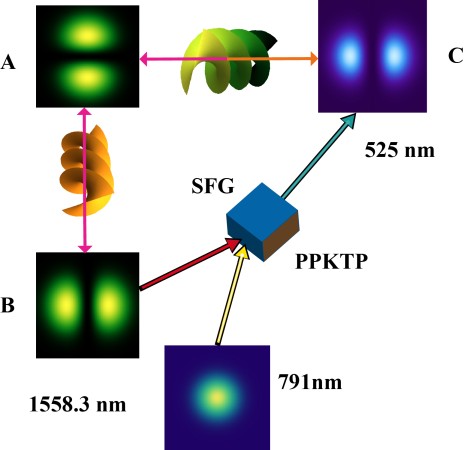The cold atomic physics research group of Key Laboratory of Quantum Information, CAS, led by academician GUO Guangcan, has achieved series of significant progresses in frequency conversion of orbital angular momentum (OAM) photonic quantum states: the group leader, Prof. SHI Baosen and his collaborators realize the frequency up-conversion of heralded single photon OAM states, OAM entanglement states and OAM-polarization hybrid entanglement states, their study clearly demonstrate that the non-classical correlation and entanglements between two photons are pertained during the up-conversion process. The main results have been published in journals "Light: Science & Applications" (Light: Sci. & Appl. 5, e10019 (2016)) and “Physical Review Letters” (Phys. Rev. Lett. 117, 103601(2016)).
Light carrying OAM has exciting applications, including the studies of fundamental quantum physics, optical manipulation and trapping of particles, astrophysics, high-precision optical measurements and optical communication, etc. In quantum information field, encoding photons with OAM degrees of freedom enables significantly increases their information-carrying capacity and network capacity due to the inherent infinite dimensions for OAM degree of freedoms. Therefore it's no surprise that many groups and researchers are active in building up a high-dimensional quantum network. So far, many important progresses have been achieved during the past years, among these important progresses, for example, Prof. SHI Baosen’s group realized the first quantum memories for storing single photon carrying OAM (Nat. Commun. 4, 2527(2013)) and OAM entanglement (Phys. Rev. Lett. 114, 050502 (2015)). In quantum communications, information carriers-photons need to transmit in low loss communication windows, while most of the physical systems for building up quantum memories and quantum processors usually operate at different wavelengths. To connect the quantum memories with the photons in low loss communication windows, a quantum interface to bridge the wavelength gap is indispensable, which can be realized by frequency conversion in nonlinear processes. One of the most important properties is the quantum correlation and entanglement of the photons should be preserved after frequency conversion. Though such a frequency transducer for single photons and entanglements in Gaussian mode has been realized, how to realize such a transducer for single photon OAM state and OAM entanglement state is still an open question.
Since 2012, Prof. SHI Baosen, Dr. ZHOU Zhiyuan and collaborators have focused on the frequency conversion of light with OAM and achieved series of progresses (OL,37, 3270 (2012); PRA, 85, 053815(2012); OE,22, 20298(2014); OE, 22, 23673(2014); J. Opt. Soc. Am. B, 32, 407 (2015)). Based on the above systematic researches, a big breakthrough has been achieved recently: by using a quasi-phase matching crystal as a nonlinear crystal, they successfully convert a heralded single photon with OAM from the telecom band to the visible band for the first time (light: Science & Applications 5, e16019(2016)) with the aid of the cavity-enhanced sum frequency generation technique, they also verify that non-classical correlation between two photons and quantum coherence are preserved during the conversion process. This work makes the first step towards realizing quantum interface for OAM photonics state. Furthermore, they realize the frequency conversion of OAM entanglement and OAM-polarization hybrid entanglement from the infrared band to the visible band, demonstrating the preservation of quantum entanglements (Phys. Rev. Lett. 117, 103601(2016)) during the frequency conversion. The above series progresses achieved will pave the way for realizing high-dimensional quantum information processing, creating a link between different quantum systems that work in different wavelengths.

Figure 1. Simplified diagram for frequency conversion of OAM entanglement state.
Moreover, these works open new doors for researches in quantum optics and nonlinear optics, which are very promising for coherent frequency conversion of high-dimensional OAM quantum states, up-conversion detection of complex spatial images in the extremely weak illumination regime and preparation of OAM beam in the short wavelength regime. In addition, these results will also have potential applications in many other fields, such as biology, astrophysics, night-vision technology, and chemical sensing, as common image detectors in infrared regime are very expensive and have low efficiency and resolution. To detect the infrared signal by up-converting it to visible regime, detected by a cheap, high efficient and resolution detector working in the visible band maybe a possible solution. Obviously, above technical achievements achieved by Prof. SHI Baosen’s group will be definitely applicable to build up-conversion detectors, which will very promising for detecting infrared images, especially signals in extremely weak illuminations regime.
This work is supported by the National Natural Science Foundation of China, the National Fundamental Research Program of China. Article links:
http://www.nature.com/lsa/journal/v5/n1/full/lsa201619a.html
http://journals.aps.org/prl/abstract/10.1103/PhysRevLett.117.103601